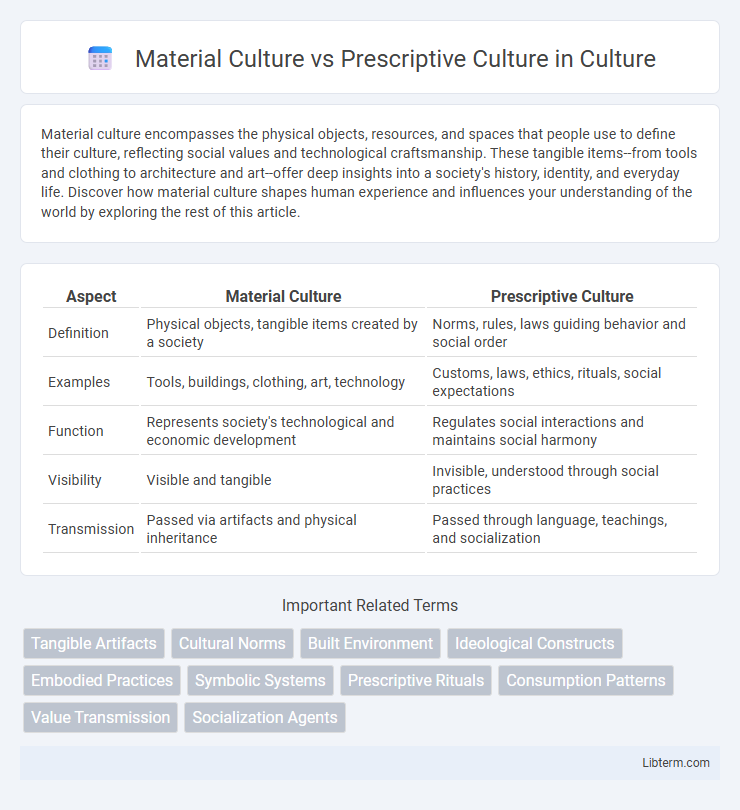Material culture encompasses the physical objects, resources, and spaces that people use to define their culture, reflecting social values and technological craftsmanship. These tangible items--from tools and clothing to architecture and art--offer deep insights into a society's history, identity, and everyday life. Discover how material culture shapes human experience and influences your understanding of the world by exploring the rest of this article.
Table of Comparison
| Aspect | Material Culture | Prescriptive Culture |
|---|---|---|
| Definition | Physical objects, tangible items created by a society | Norms, rules, laws guiding behavior and social order |
| Examples | Tools, buildings, clothing, art, technology | Customs, laws, ethics, rituals, social expectations |
| Function | Represents society's technological and economic development | Regulates social interactions and maintains social harmony |
| Visibility | Visible and tangible | Invisible, understood through social practices |
| Transmission | Passed via artifacts and physical inheritance | Passed through language, teachings, and socialization |
Introduction to Material and Prescriptive Culture
Material culture encompasses the physical objects, artifacts, and technological tools created and utilized by a society, reflecting its tangible heritage and daily practices. Prescriptive culture refers to the intangible norms, rules, and social expectations that guide behavior and interactions within a community, shaping its ethical and moral frameworks. Together, these dimensions provide a comprehensive understanding of both the concrete and ideological components that define human societies.
Defining Material Culture
Material culture encompasses the physical objects, artifacts, and technologies created and used by a society, reflecting its values, beliefs, and social structures. It includes tools, clothing, buildings, art, and other tangible items that provide insight into the daily lives and historical context of a community. Understanding material culture is essential for anthropologists and historians to analyze cultural development and human interaction with the environment.
Understanding Prescriptive Culture
Prescriptive culture encompasses the norms, values, and rules that guide individual behavior within a society, shaping social expectations and moral codes. Unlike material culture, which involves physical objects and artifacts, prescriptive culture governs intangible elements such as customs, laws, and ethical beliefs. Understanding prescriptive culture is essential for analyzing social cohesion and the mechanisms through which societies maintain order and transmit cultural knowledge across generations.
Key Differences Between Material and Prescriptive Culture
Material culture encompasses tangible objects, artifacts, and physical creations shaped by a society, reflecting its technological advancements and aesthetic values. In contrast, prescriptive culture involves the intangible norms, rules, laws, and ethical guidelines that govern behavior and social expectations within a community. The key difference lies in material culture's focus on physical manifestations of human activity, while prescriptive culture centers on the ideological frameworks that direct social conduct.
The Role of Objects in Shaping Material Culture
Objects serve as tangible expressions of material culture, embedding social values, technological advancements, and historical context within their design and usage. These artifacts influence everyday behaviors and societal norms by providing physical evidence of cultural practices, enabling communities to transmit traditions across generations. The interaction with objects shapes collective identity, reflecting shifting cultural priorities and the prescriptive frameworks that guide societal expectations.
Social Norms and Rules in Prescriptive Culture
Prescriptive culture establishes social norms and rules that dictate acceptable behavior, creating structured guidelines for individuals within a society. These norms are often codified in laws, customs, or religious doctrines, ensuring conformity and social order. In contrast, material culture encompasses tangible artifacts that reflect and influence these social rules but do not inherently prescribe behavior.
Interactions and Overlaps Between the Two Cultures
Material culture and prescriptive culture frequently intersect in shaping societal norms and behaviors, as tangible artifacts often embody the values and rules dictated by prescriptive frameworks. The production and use of objects like religious icons, tools, or clothing reflect and reinforce prescriptive cultural codes, creating a feedback loop between material expressions and societal expectations. These interactions highlight how material culture not only represents but also actively influences prescriptive norms, leading to continuous evolution within both domains.
Impacts on Identity and Group Belonging
Material culture, comprising physical objects like clothing, tools, and art, shapes identity by providing tangible symbols that individuals use to express group membership and heritage. Prescriptive culture involves shared norms, values, and customs that dictate behavior and social roles, reinforcing group belonging through collective expectations and rituals. The interplay between material and prescriptive culture solidifies social cohesion by linking outward expressions with internalized cultural meanings, fostering a strong sense of identity within communities.
Contemporary Examples: Material vs. Prescriptive Culture
Material culture includes tangible objects like smartphones, architecture, and fashion that reflect contemporary societal values and technological advancements. Prescriptive culture encompasses unwritten social norms, ethical codes, and customs guiding behaviors, such as remote work etiquette or environmental sustainability practices. The rise of digital technology illustrates material culture through devices, while online privacy norms and netiquette exemplify prescriptive culture shaping modern interactions.
Conclusion: Importance in Sociocultural Studies
Material culture, encompassing physical objects and artifacts, provides tangible evidence for understanding past human behaviors and social structures, while prescriptive culture reflects the norms, values, and rules guiding social conduct. Both dimensions are crucial in sociocultural studies for a holistic interpretation of societies, revealing the dynamic interplay between presence and practice. Integrating material and prescriptive cultural analysis enhances insights into cultural evolution, identity formation, and sociohistorical contexts.
Material Culture Infographic

 libterm.com
libterm.com